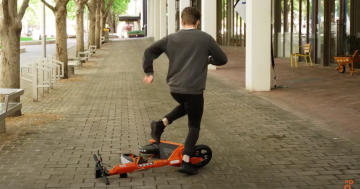
Researchers are calling for new and expanded measures to ensure the safety of e-scooter riders. Photo: Michelle Kroll.
A university study has found that Canberra’s e-scooters are mostly being ridden by young people knowingly engaging in risky behaviour, such as carrying multiple passengers or not wearing a helmet, despite being aware that “some of those risks are going to be severe”.
University of Canberra Associate Professor Amanda George, who specialises in studying risky behaviour in young adults, led the two-part study that reviewed 1200 observations of e-scooter riders and interviewed e-scooter riders in a series of focus groups.
One focus group participant reported that while they understood some of their risky behaviour on e-scooters was “severe” and they could be injured, they wanted to fit in with their friends who were behaving that way.
“One of the key findings was this perception that [wearing a helmet] is just not the norm, given that most people do not wear one,” Assoc Prof George said.
“It’s not something to think about [when someone rides an e-scooter].”
Some participants defended not wearing a helmet as they saw riding an e-scooter as a low-risk activity, while others said they didn’t want to stand out from their mates by wearing one.
For shared e-scooters, some noted there wasn’t a helmet available for all passengers, while others said it was unhygienic or damaged.
Under ACT regulations, e-scooter riders must wear a helmet and only one person per e-scooter is permitted.
The researchers also found a lack of understanding about the laws around e-scooter use, with one participant saying the information wasn’t “readily available or not somewhere that somebody would really look or really care about”.
“The laws of using an e-scooter in Canberra are different in NSW and vice versa. There are some differences, and that can make it complicated,” Assoc Prof George said.
The research team selected four locations across Civic, Braddon, and Lake Burley Griffin to observe riders over four days.
They found nearly half the riders weren’t wearing their helmet (48 per cent), with riders on 64 per cent of shared e-scooter riders and 31 per cent of privately owned scooters not wearing one.
“[This] is higher than in other jurisdictions … and it was also a lot higher than in self-reported data we have from other researchers in Canberra,” Assoc Prof George said.
According to the paper, a lack of helmets was particularly common at the observation sites in Civic and Braddon, as well as during the Saturday observations.
“When multiple predictors of not wearing a helmet were considered, it was identified that apparent age group, scooter type, location and apparent gender were all important predictors of not wearing a helmet,” the paper stated.
Seven per cent of e-scooter rides were apparently speeding (no actual speed was recorded), 3 per cent of e-scooters had extra passengers and 11 per cent rode on the road when a pathway was available.
Assoc Prof George said the findings likely underreported what was happening on Canberra’s streets, as the study had an observation cut-off at 9:30 pm.
“We certainly know that greater risk taking, including lack of helmet use, happens in very late night periods,” she said.
School holidays and Easter were excluded from the study as the researchers wanted to capture normal behaviour.
E-scooter riders were observed from 7:30 am to 9:30 am, 11:30 am to 1:30 pm and 4:30 pm to 6.30 pm, and from 7:30 pm to 9:30 pm on Friday and Saturday evenings.
Assoc Prof George said strategies around safer e-scooter use would need to target the wider community.
“What we’ve identified through the focus groups is that the risk can increase for those who are using them infrequently, who are just picking them up for the first time,” she said.
“They’re not aware of how they should be used … [and] if you’re doing it in a group and you’re trying to keep up with everybody, obviously all of those risks are going to increase.”
The researchers are calling for several safety measures, including further clarity on laws surrounding e-scooter use and the upkeep of infrastructure (such as footpaths) so that people feel comfortable riding them in designated areas.
Assoc Prof George said future studies were needed on e-scooter use, especially among young people.
“Hopefully, with the next lot of research that we’re conducting, we’ll be able to provide some more targeted strategies addressing specific psychological practice.”
The Safe and Unsafe E-Scooter Behaviours in the ACT study was funded through the ACT Road Safety Fund Community Grant Program.
Original Article published by Claire Sams on Region Canberra.







